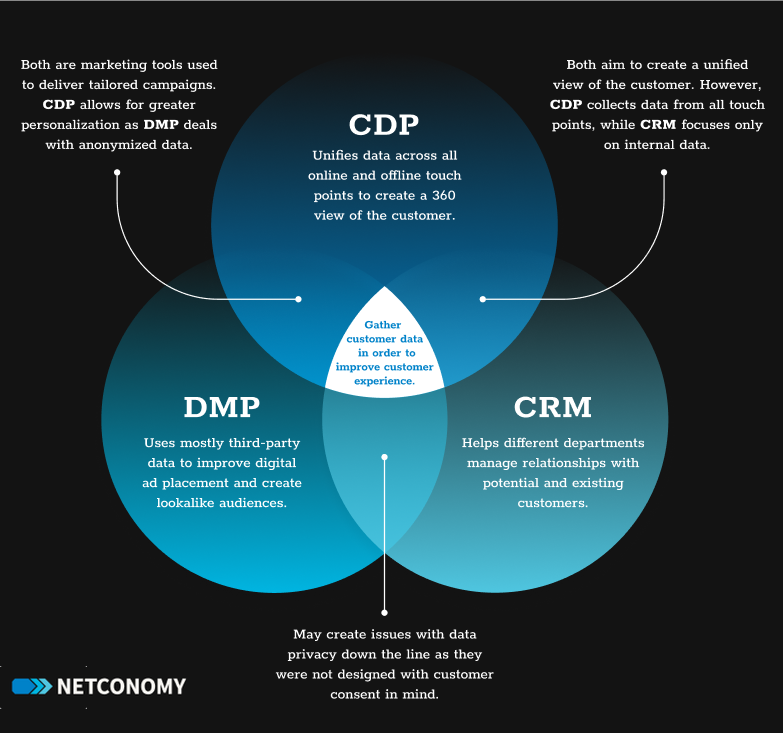Over the past couple of years, marketers have become more data-driven and eager to find the right tools to get a full view of their customers. In addition, they want to view data more holistically and less siloed.
As a result, the MarTech landscape exploded, flooding the market with new tools promising to give you the data you need to succeed. But with such a wide choice, it’s hard to keep track of their distinctive features and the goals they will help you accomplish.
Customer relationship management (CRM) systems, data management platforms (DMP), and customer data platforms (CDP) are often confused with each other. The truth is – they all play an essential role in delivering exceptional customer experiences. And you use all of them to gather and manage data from different sources.
However, if you dig deeper, those platforms have different goals and requirements. The fundamental difference is the type of data collected by each platform and how it’s shared within the organization. This directly impacts the ways customer profile is seen through each system – and the follow-up actions marketers can trigger going forward.
In this article, we’ll discuss these solutions and help you understand their differences and similarities. You’ll then be able to choose the platform that will help you overcome your challenges while considering your specific business context.
What this article covers:
What are DMP, CRM, and CDP?
According to Gartner, a data management platform is “a software that controls the flow of data in and out of an organization”. It is mainly used for data-driven ad strategies, such as segmentation, to allow marketers to launch targeted advertising initiatives.
DMPs can pull data from:
- internal sources – such as CRM software, website, or email
- external sources – connecting to third-party data brokers or corporate partners
The data is then used to build customer profiles and, ultimately – audiences and lookalike audiences, which are later sent to digital ad platforms for targeting.
When it comes to CRM, the name gives you a hint. CRM is a platform that allows different departments across your organization to manage relationships with their customers.
CRM uses data such as:
- name
- email
- items purchased
- payment methods, etc.
Customer details and purchase history are combined to help you understand customer preferences and behavior. Gartner defines CRM as “a business strategy that optimizes revenue and profitability while promoting customer satisfaction and loyalty”.
For CDP, the definition is much more comprehensive. CDP is a “marketing technology that unifies a company’s customer data from marketing and other channels to enable customer modeling and optimize the timing and targeting of messages and offers”.
A customer data platform is a tool known for providing a truly unique view of the customer – and using it to trigger personalized actions.
That means CDP can connect and integrate with various tools and systems, such as:
- CRM
- customer service
- transactional software
- social media
- email
- website analytics
CDPs can use the data from first-party, second-party, and third-party sources and therefore provide the full service for data-driven marketers – from data collection to activation. In fact, activation is one of the core features of CDPs, as it supports your ability to engage with customers on their terms.
Now that we have covered each platform’s basics let’s look at how they compare individually.

Customer data platform vs data management platform
Even though they are both considered marketing tools that help organizations deliver tailored campaigns, the level of personalization is the key difference.
DMP uses third-party and some (anonymized) first-party data to build segments and audiences. This information is shared with digital ad platforms that serve ads to potential prospects, including lookalike audiences.
DMPs don’t store PII (Personally Identifiable Information) but focus on creating and sharing audiences. That means DMP can help you assign your customer to a specific segment and deliver ads based on the preferences of the entire group. However, it doesn’t allow you to view the unique characteristics of a single customer and respond to their needs in real-time.
On the other hand, CDPs gather first-party data combined with some third-party data. They empower all stages of marketing activities and can integrate with all “take action” systems. CDP data retention is typically much longer than DMPs, allowing you to analyze customer behavior over a longer period, predict needs and actions, and deliver true personalization.
Customer data platform vs CRM
CRM is a “customer-facing” system that helps you optimize and enhance interactions with known customers. They track transactions, keep the data provided by sales and marketing, and help you identify and nurture opportunities.
CRMs are used by sales, marketing, customer service, and digital commerce, although their chief user is the sales department. CRM does not trigger marketing actions – that happens through other marketing tools integrated with it (which is very often a CDP tool).
Unlike CDPs, CRMs cannot ingest data in real-time from any source. Instead, they gather data from a limited number of sources and mainly deal with first-party data. This makes it impossible for you to get a 360 customer view unless you integrate them with another solution, such as customer data platform tools. In addition, because of the high dependency on manual data entry, the quality of the actual data in the CRM is often questionable.
CDP has an essential capability that CRM doesn’t. It can retrieve offline data and track customer behavior across social media and the internet – beyond your organization’s website and the data entered into CRM. In general, CRM is an important tool for driving customer retention and loyalty. Still, it is only part of a broader strategy to enable end-to-end customer interaction and deliver personalized communications in real-time.
Why choose CDP
Data silos have become a common problem for many organizations – and not only for marketers. But unfortunately, in the race to purchase new tools and systems for better customer engagement, the opposite is happening. Organizations are missing out on opportunities because they don’t have a unified customer view across the entire organization.
To make matters worse, targeting prospects based on DMPs is becoming impossible, as third-party cookies are going away. And with customers wanting a more personalized engagement at every touch point – CDP is positioned as the number one platform that can empower you to deliver.
CDP is a platform built to meet the growing needs of a modern marketer. It is the only tool that helps you facilitate customer interactions and engagement across the entire lifecycle.
It doesn’t only gather data from different sources to build a 360 customer view. It also triggers actions in various engagement systems. All of that is done based on customer consent and preference, ensuring that you are compliant with current regulatory standards.
Think no more: Customer Data Platform is the best-of-breed system for delivering personalized, tailored customer experience.







